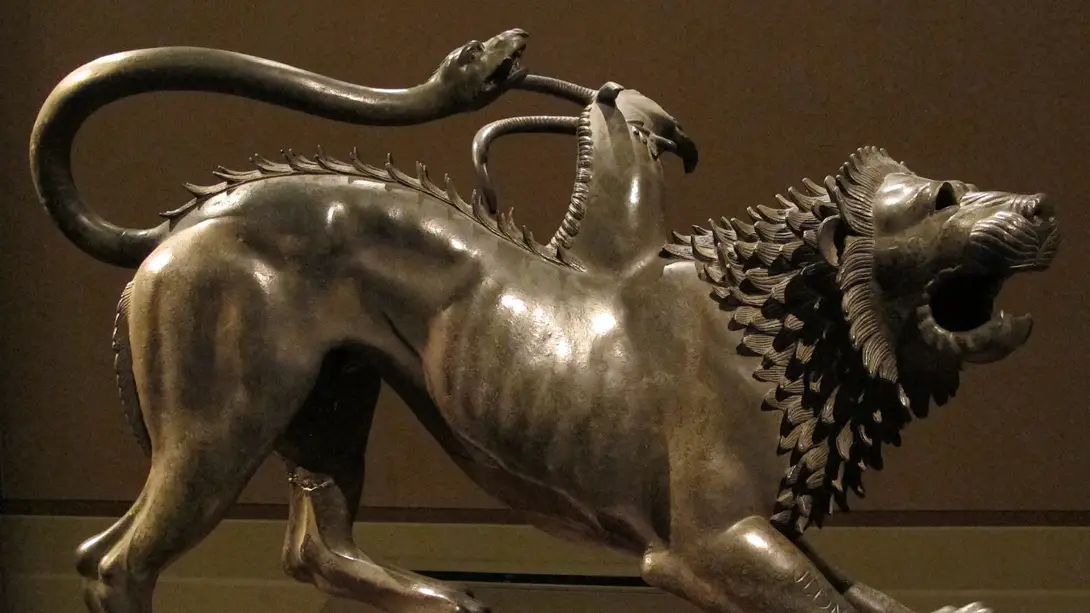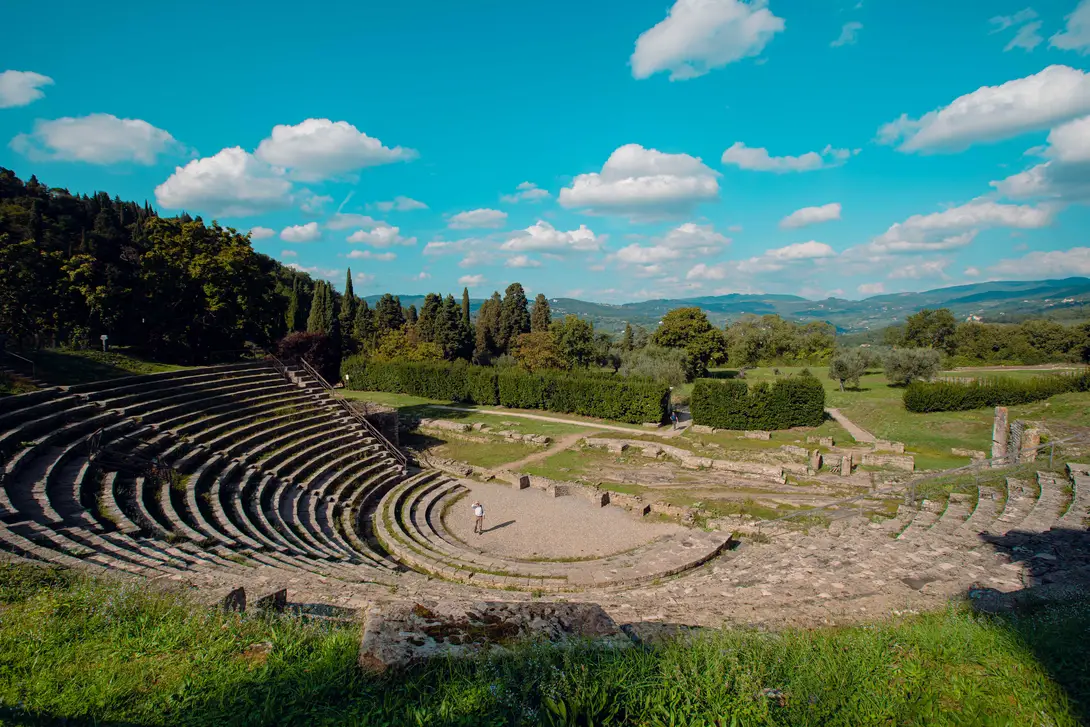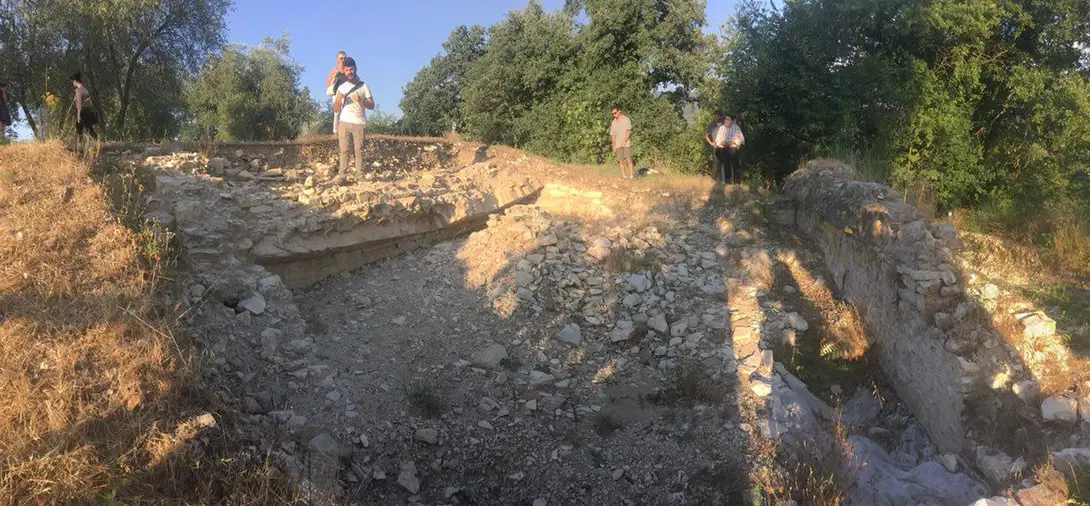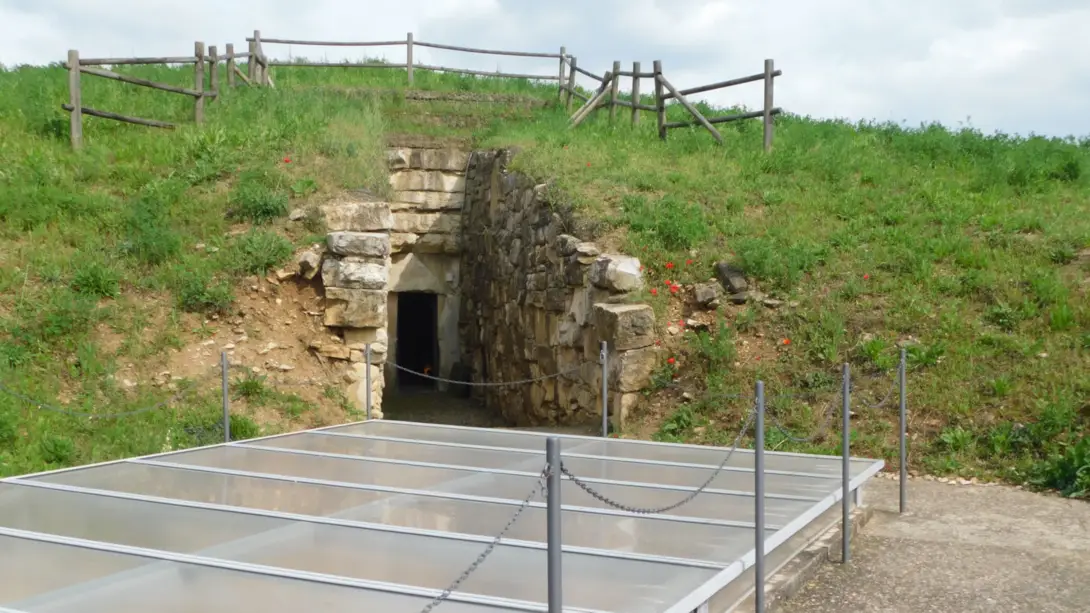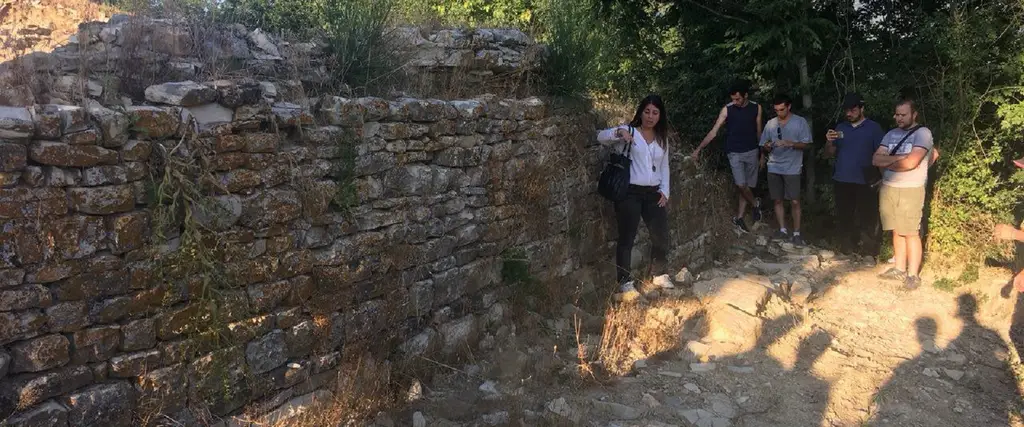
Kleine archäologische Route
Sich umzudrehen und nach Spuren der Vergangenheit zu suchen, ist eine Tätigkeit, die sich gut für die Erkundung unserer Region eignet.
Etrusker, Römer, Mittelalter: Kennen Sie die archäologischen Stätten in der Umgebung von Florenz?
Diese kleine Route führt uns an die Hand und lässt uns alte Zivilisationen entdecken, unsere Vorfahren, die dieses Land bewohnt, diese Felder bebaut, diesen Stein bearbeitet und diese Bäume gepflanzt haben.
Wir wollen in Florenz starten, wo es ein paar wichtige Institutionen gibt, wie das Archäologische Nationalmuseum oder die versteckten Ausgrabungen, die man nicht sehen kann, weil sie unter den Schichten der Stadt begraben sind, die Jahrhundert für Jahrhundert darüber gebaut wurde. Wir meinen die mittelalterliche Kathedrale Santa Reparata, deren Krypta unter dem heutigen Dom besichtigt werden kann, oder das Römische Theater, das sich direkt unter dem Palazzo Vecchio befindet.
Wir begeben uns nach Fiesole, wo die etruskischen und später römischen Bauwerke auf bewundernswerte Weise erhalten geblieben sind und im Archäologischen Areal und im Museum allen Besuchern gezeigt werden, die von diesem Ort verzaubert sind.
Wir verlassen die Stadt in Richtung Valdarno, genauer gesagt in die Gemeinde Rignano sull'Arno, wo sich auf dem Gelände der Fattoria di Pagnana die Ausgrabungsstätte Castelluccio befindet, eine Wohnsiedlung, eine kleine Burg aus dem Mittelalter.
Was hingegen die sogenannte Piana betrifft, also das Gebiet westlich von Florenz, so finden wir dort majestätische Beispiele für etruskische Tholosgräber, insbesondere in der Gemeinde Sesto Fiorentino das Grab von Montagnola.
Unsere kleine Reise endet in Campi Bisenzio, im Archäologischen Museum von Gonfienti in der Rocca Strozzi: Hier sind Fundstücke aus drei Epochen ausgestellt, der Bronzezeit, der etruskischen und der römischen Zeit.
Comune di Rignano sull'Arno
Die Orte
Etappen
Archeologiches Nationalmuseum
Das Archäologische Nationalmuseum befindet sich im Palazzo della Crocetta (17. Jahrhundert erbaut), wohin am Ende des 19. Jahrhunderts die Antiquitätensammlungen der Medici und Lothringer von den Uffizien versetzt wurden.
Der Hauptkern dieser Sammlung besteht aus Zeugnissen der etruskischen Zivilisation, darunter die großen Bronzestatuen der Chimäre und des Arringatore (Redner). Eine reiche Abteilung ist den Grabskulpturen gewidmet ( Sarkophage und Urnen, mit Mythen und Darstellungen der Verstobenen, bei einem Festmahl im Jenseits verziert) sowie den griechischen Vase, die in den aristokrakischen Gräbern Etruriens gefunden wurden: Darunter sticht der große attische Schwarzfiguren-Krater hervor, der als François-Vase (nach seinem Entdecker benannt) bekannt und mit zahlreichen mythologischen Motiven verziert ist.
Im Museum sind einzigartigeExemplare etruskischer und römischer Bronzen, Edelsteine, Kameen und antike Münzen von großem historischem und künstlerischem Wert zu finden. Die Ägyptische Abteilungdes Museums, die zweitgrößte Italiens nach Turin, wurde größtenteils dank einer französisch-toskanischen Expedition nach Ägypten im Jahr 1828 aufgebaut. Die Sammlung umfasst Vasen, Skulpturen, Sarkophage mit Mumien, Papyri, Amulette und Kleinbronzen aus verschiedenen Epochen von der prähistorischen Zeit bis zum Beginn der christlichen Zeit.
Das Archäologische Museum ist auchalsFreilichtmuseum zu bewundern: Im Garten befinden sich nämlich ganze archäologische Monumente, die von ihren ursprünglichen Stätten abgebaut und hier wiederaufgebaut wurden. Der Garten ist geschlossen.
Das Museum ist besonders für Kinder geeignet, vor allem für die im Schulalter: Hier werden regelmäßig Workshops und Aktivitäten für Familien und junge Besucher organisiert
Krypta der S. Reparata (Kathedrale Innenraum)
Vom Inneren des Doms erreicht man die archäologischen Ausgrabungen, die die Resten von der antiken Kathedrale Santa Reparata beherbergen: ein Zeugnis des frühesten Christentums in Florenz.Die Kirche aus dem 6. Jahrhundert hat in der romanischen Zeit weitere Veränderungen (z.B der Bau der Krypta) erfahren, und blieb auch bis zur Fertigstellung des Neubaus in Betrieb, danach sie abgerissen wurde.Heute werden hier römische und mittelalterliche Funde, Grabplatten und Fragmente des polychromen Mosaikbodens mit geometrischen Verzierungen bewahrt.
Der Architekt der Kuppel, Filippo Brunelleschi, ist hier begraben.
Palazzo Vecchio - Ausgrabungen des römischen Theaters
Der imposante Palazzo Vecchio erhebt sich über den Überresten des antiken römischen Theaters von Florentia. Nur wenige Stufen hinab und Sie fühlen sich in die Vergangenheit zurückversetzt! Das Bauwerk bot Platz für etwa 10.000 Zuschauer und hatte einen Außendurchmesser von 100 Metern. Der Zuschauerraum (Cavea) lag an der Piazza Signoria, die Bühne an der Via de’ Leoni. Erbaut nach der Gründung Florentias, wurde das römische Theater zu Beginn des 2. Jahrhunderts n. Chr. erweitert, was mit dem beträchtlichen Bevölkerungswachstum und der Stadtentwicklung der Kaiserzeit zusammenfiel.
Es wurde – anders als das Amphitheater im Viertel Santa Croce – bis ins 5. Jahrhundert hauptsächlich für Prosaaufführungen genutzt. Danach begann sein Niedergang bzw. Zerstörung verschiedener Baumaterialien, unsachgemäße "Wiederverwendung" einiger Bereiche, wie der "Burelle", der radial gemauerten Gänge unterhalb der Cavea.
Bestätigt durch Untersuchungen im 19. Jahrhundert, es folgten bedeutende archäologische Ausgrabungen, die die Eröffnung für die Öffentlichkeit ermöglichten.
Archaeological Museum and Archaeological area
The museum exhibits chart the ancient history of Fiesole and the surrounding area: human presence in the zone dates back at least as far as the Bronze Age (around 2000 BC), while the cityitself began to develop at the end of the 4th century BC. Fiesole was an important Etruscan settlement, occupying a strategic position controlling routes between southern Etruria and the Etruscan settlements in the Po area, and a bulwark against invasions from northern peoples, in particular the Gauls. It became a Roman colony in 80 BC, though it retained its Etruscan characteristics: in fact, the Romans chose to settle in the valley, founding Florence.
The museum is connected to the Archaeological Zone, comprising the excavations of a theatre, baths and an Etruscan-Roman temple. The museum also houses the Costantini Collection, consisting of ancient Greek vasesand a reconstructedLombard tomb. Also of note are various Etruscan bronzes, black- and red-figure Greek and Etruscan ceramics, and marble friezes from the Roman theatre.
Il Castelluccio - archaeological site
The archaeological area of Castelluccio occupies a small hill in the relief overlooking the Valdarno area of Rignano.
Given its proven nature as a sealed stratigraphic deposit, the presence of significant elevations and the availability of documentary sources represents a valuable historical and archaeological evidence of the birth, development, abandonment and repopulation of a fortified settlement which, in addition to being a significant nucleus of aggregation since the 11th century, played an important role during the central centuries of the late Middle Ages, as part of the conquests of the countryside made by Florence.
The importance of this castle, in a territory characterized by a scattered population, where the percentage of sites with remains of medieval settlements is very high, is given in particular by its strategic position to control the ford on the Arno and the ancient road network to reach the Florentine plain.
Etruscan Tomb of La Montagnola
Since centuries in Quinto, on the slopes of Monte Morello, there rises La Montagnola (the little mountain) - a mound of earth which due to its regular shape, had long suggested an artificial origin. In 1959, excavation works led to the discovery of an Etruscan tomb among the largest yet known.
The tomb dates back to the second half of the 7th century BC and is part of a series of archaeological sites - including the nearby tomb of La Mula - which testify to an ancient Etruscan presence in what today is the territory of Sesto Fiorentino.
It is a thòlos tomb made up almost entirely of large blocks of alberese limestone, and buried beneath an imposing mound of earth. Roughly circular at its base, the mound has a perimeter of about 125 meters, and a diameter of about 70 meters.
The interior of the tomb is accessed from the external dromos, an open-air corridor made of stone blocks. The corridor extends for 14 meters up to the entrance of the internal dromos, which continues inside for about 7 meters more.
Facing each other, two rectangular burial chambers open out from the middle of the internal dromos. By the entrance of one of these chambers, there is a large stone slab which feature - vaguely visible to the naked eye - traces of paintings depicting animals and ornamental motifs, along with some writings in the distinctive Etruscan alphabet.
The internal dromos leads to the entrance of the thòlos - a large circular burial chamber, with a diameter of about 5 meters and of equal height. This chamber is constituted by an ogival dome, made up of massive blocks of alberese limestone. At the centre of the thòlos lies a pillar made of tuff blocks, originally covered with clay and dark stucco; the pillar has no load-bearing function: it could have had, rather, an astronomical or religious function.
The tomb was found to have already been desecrated in the centuries before its discovery. In spite of this, archaeologists recovered a number of objects which, due to the quality of the materials and decorations, testify to the wealth and rank of the proprietary family. These objects are identified with the Orientalizing Etruscan period (spanning from the 7th to the 6th century BC), and are now preserved in the National Archeological Museum of Florence.
In 2001, during works of renovation, the foundations of a secondary tomb were discovered right before the entrance of the main tomb. Dating to the first half of the 7th century BC, and much more modest in size, this second tomb consisted of a single rectangular cell subdivided into two rooms.
Archaeological Museum of Gonfienti
Open since July 2022, the museum collects the archaeological remains that were found in the archaeological site of Gonfienti, between the municipalities of Prato and Campi Bisenzio and is located inside the Rocca Strozzi, that has been made available by the Municipality of Campi Bisenzio to the Superintendence of Archaeological Heritage of Tuscany.
The visitor route follows the three periods in which the site of Gonfienti was inhabited: the Bronze Age, the Etruscan period and the Roman one, with remains datable from the 16th century B.C. to the 4th century A.D.
The excavation campaigns have shown that Gonfienti was one of the largest settlements of Northern Italy, and it was inhabited continuously from the 16th to the 13th century B.C.; the numerous ceramic findings that were rediscovered testify to the daily activity of the village, especially for the production, preservation and consumption of food.
The vast Etruscan settlement, founded between the 6th and 5th, was organised according to a regular urban model; standing out among the various sectors that have been explored to date is the large residential building of Lot 14, that is developed on a rectangular plan of over 14000 sqm; the roof of this building, with tiles and antefixes of fine workmanship, has been reconstructed.
Even the Roman settlement has given us traces of a large building of imperial Roman times, with a series of rooms overlooking a central courtyard; on display is a portion of the "Tabula Peutingeriana" from this era, the ancient Roman map that shows the road system in the territories of the Empire.
